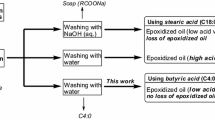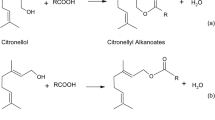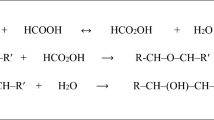Abstract
The objective of the research was the synthesis of linoleic acid hydroperoxides (HPOD) and their recovery, using selected sources of linoleic acid (LA) as substrate. This is part of on-going work aimed at the development of an economically viable biotechnological process for the production of natural flavors. The investigated sources included pure (100 %) LA and commercial (67 %) LA as well as safflower oil (SO) and its hydrolyzed product. A model describing commercial LA oxidation by lipoxygenase, based on Michaelis–Menten kinetics, was developed. The conversion of pure LA and commercial LA resulted in insignificant differences in HPOD yield of 69.7 and 68.9 %, respectively. However, there was a significant difference in the HPOD yield, obtained from the SO (2.0 %) and that from the hydrolyzed SO (58.0 %) in comparison to that from pure LA (69.7 %). The ratios of the different 9- and 13-HPOD isomers were insignificantly different for the sources containing free LA, with 13-(9Z,11E)-HPOD was the highest relative percentage. Using optimized conditions, HPOD yields were 85.9 and 74.0 % for the commercial LA and the hydrolyzed SO, respectively. Based on experimental findings, commercial (67 %) LA was selected as the most appropriate alternative to pure LA for the production of HPOD. An efficient extraction procedure for the recovery of HPOD was also developed.







Similar content being viewed by others
References
Villaverde JJ, Santos SAO, Haarmann T, Neto CP, Simões MMQ, Domingues MRM, Silvestre AJD (2013) Cloned Pseudomonas aeruginosa lipoxygenase as efficient approach for the clean conversion of linoleic acid into valuable hydroperoxides. Chem Engineer J 231:519–525
Buchhaupt M, Guder JC, Etschmann MM, Schrader J (2012) Synthesis of green note aroma compounds by biotransformation of fatty acids using yeast cells coexpressing lipoxygenase and hydroperoxide lyase. Appl Microbiol Biotechnol 93:159–168
Schwab W, Davidovich-Rikanati R, Lewinsohn E (2008) Biosynthesis of plant-derived flavor compounds. Plant J 54:712–732
Fauconnier M-L, Marlier M (1996) An efficient procedure for the production of fatty acid hydroperoxides from hydrolyzed flax seed oil and soybean lipoxygenase. Biotechnol Tech 10:839–844
Fukushige H, Wang C, Simpson TD, Gardner HW, Hildebrand DF (2005) Purification and identification of linoleic acid hydroperoxides generated by soybean seed lipoxygenases 2 and 3. J Agric Food Chem 53:5691–5694
Márczy JS, Németh AS, Samu Z, Háger-Veress A, Szajáni B (2002) Production of hexanal from hydrolyzed safflower oil by lipoxygenase and hydroperoxide lyase enzymes. Biotechnol Lett 24:1673–1675
Freitas L, Bueno T, Perez VH, Santos JC, Castro HF (2007) Enzymatic hydrolysis of soybean oil using lipase from different sources to yield concentrated of polyunsaturated fatty acids. World J Microbiol Biotechnol 23:1725–1731
Maidina AB, Belova AB, Levashov AV, Klyachko NL (2008) Choice of temperature for safflower oil hydrolysis catalyzed by Candida rugosa lipase. Moscow Univ Chem Bull 63:108–110
Noordermeer MA, Van Der Goot W, Van Kooij AJ, Veldsink JW, Veldink GA, Vliegenthart JFG (2002) Development of a biocatalytic process for the production of C6-aldehydes from vegetable oils by soybean lipoxygenase and recombinant hydroperoxide lyase. J Agric Food Chem 50:4270–4274
Perraud X, Kermasha S (2000) Characterization of lipoxygenase extracts from Penicillium sp. J Am Oil Chem Soc 77:335–342
Serri NA, Kamarudin AH, Abdul Rahaman SN (2008) Preliminary studies for production of fatty acids from hydrolysis of cooking palm oil using C. rugosa lipase. J Phys Sci 19:79–88
Badings HT, De Jong C (1983) Glass capillary gas chromatography of fatty acid methyl esters. A study of conditions for the quantitative analysis of short- and long-chain fatty acids in lipids. J Chromatogr 279:493–506
Bisakowski B, Perraud X, Kermasha S (1997) Characterization of hydroperoxides and carbonyl compounds obtained by lipoxygenase extracts of selected microorganisms. Biosci Biotechnol Biochem 61:1262–1269
Kermasha S, Perraud X, Bisakowski B, Husson F (2002) Production of flavor compounds by hydroperoxide lyase from enzymatic extracts of Penicillium sp. J Mol Catal B: Enz 19–20:479–487
Martini D, Iacazio G, Ferrand D, Buono G, Triantaphylides C (1994) Optimization of large scale preparation of 13-(S)-hydroperoxy-9Z,11E-octadecadienoic acid using soybean lipoxygenase. Application of the chemoenzymatic synthesis of (+)-coriolic acid. Biocatal 11:47–63
Villaverde JJ, van der Vlist V, Santos SAO, Haarmann T, Langfelder K, Pirttimaa M, Nyyssölä A, Jylhä S, Tamminen T, Kruus K, de Graaff L, Neto CP, Simões MMQ, Domingues MRM, Silvestre AJD, Eidner J, Buchert J (2013) Hydroperoxide production from linoleic acid by heterologous Gaeumannomyces graminis tritici lipoxygenase: optimization and scale-up. Chem Engineer J 217:82–90
Németh AS, Márczy JS, Samu Z, Háger-Veress A, Szajáni B (2004) Biocatalytic production of 2(E)-hexenal from hydrolysed linseed oil. Enz Microb Technol 34:667–672
Srinivasulu S, Appu Rao AG (1993) Kinetics and structural studies on the interaction of surfactants with lipoxygenase L1 from soybeans (Glycine max). J Agric Food Chem 41:366–371
Savelli G, Spreti N, Di Profio P (2000) Enzyme activity and stability control by amphiphilic self-organizing systems in aqueous solutions. Curr Opin Colloid Interface Sci 5:111–117
Gargouri M, Ben Akacha N, Legoy M-D (2004) Coupled hydroperoxide lyase and alcohol dehydrogenase for selective synthesis of aldehyde or alcohol. Appl Biochem Biotechnol 119:171–180
Ben Akacha N, Karboune S, Gargouri M, Kermasha S (2010) Activation and stabilization of the hydroperoxide lyase enzymatic extract from mint leaves (Mentha spicata) using selected chemical additives. Appl Biochem Biotechnol 160:901–911
Acknowledgments
This research was supported by a Discovery Grant from the Natural Sciences and Engineering Research Council of Canada (NSERC). Marya Aziz was the recipient of a M.Sc. graduate student fellowship, from the Fonds de Recherche sur la Nature et les Technologies (FQRNT) as well as a Ph.D. graduate fellowship, awarded by the NSERC.
Author information
Authors and Affiliations
Corresponding author
About this article
Cite this article
Aziz, M., Ben Akacha, N., Husson, F. et al. Synthesis of Linoleic Acid Hydroperoxides as Flavor Precursors, Using Selected Substrate Sources. J Am Oil Chem Soc 91, 1867–1876 (2014). https://doi.org/10.1007/s11746-014-2543-x
Received:
Revised:
Accepted:
Published:
Issue Date:
DOI: https://doi.org/10.1007/s11746-014-2543-x




